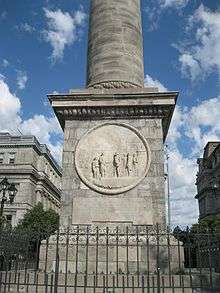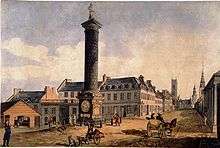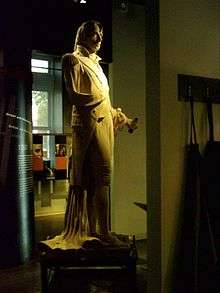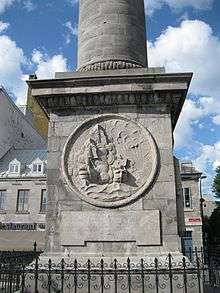Nelson's Column, Montreal
Coordinates: 45°30′30″N 73°33′14″W / 45.50833°N 73.55389°W
| French: Colonne Nelson | |
|
| |
| Location |
Place Jacques-Cartier Old Montreal |
|---|---|
| Material | stone |
| Height | 62 ft (19 m) |
| Beginning date | August 17, 1809 |
| Dedicated to | Horatio Nelson |
Nelson's Column (French: Colonne Nelson) is a monument erected in 1809 at Place Jacques-Cartier, Montreal, Quebec, dedicated to the memory of Admiral Horatio Nelson following his death at the Battle of Trafalgar. Since the destruction of Dublin's Nelson's Pillar (1808–1966), Montreal's now stands as the second oldest "Nelson's Column" in the world after the one in Glasgow,[1] and is also the city's oldest monument and is the oldest war monument in Canada. Neither the French Revolution nor Napoleon had been popular among the French in Montreal, and contrary to later belief, the public funds raised for the monument were collected from British and French Montrealers alike.
History





According to popular memory (and since repeated by Rumilly and Leacock), Montrealers first became aware of Nelson's death on a snowy New Year's Eve in 1805. As river navigation was closed for the winter, word reached Montreal overland via New York City when a ball being hosted by Samuel Gerrard was interrupted by the messenger. Gerrard immediately went down to the Exchange Coffee House to publicly relay the news while proposing that a monument be built to honour both Nelson's memory and his victory over Napoleon's fleet.[2] A number of people subscribed on the spot and a list was left open in the Old Court House where over the following weeks further names were added.[3]
In January 1806, a committee of five, consisting of John Richardson, Louis Chaboillez, John Forsyth, Sir James Monk, Sir John Johnson and John Ogilvie, was formed in conjunction with Sir Alexander Mackenzie, Thomas Forsyth and John Gillespie, in London, to raise public funds and organise the building of the monument. Among the principal contributors to the fund were Gerrard himself, Alain Chartier de Lotbinière, William McGillivray, members of the Panet family (including Jean-Antoine Panet), Joseph Frobisher, Jacques-Philippe Saveuse de Beaujeu, Alexander Henry, the Beaubien family, James McGill, the Fleury desChambault family, John Ogilvy and the "gentlemen of Saint-Sulpice".[4] The Sulpicians, like many other French Canadians, strongly disapproved of the French Revolution and the subsequent Napoleonic regime, thereby regarding the destruction of Napoleon's navy at Trafalgar as "a triumph of virtue".[5]
The magistrates of Montreal obtained from Governor Sir James Craig a plot of land that had a few years before constituted part of the formal gardens of the Château Vaudreuil, built in 1723 for Philippe de Rigaud, Marquis de Vaudreuil. The Chateau burned down in 1803 and since then the space formerly occupied by the gardens had been turned into a public square, known as New Market Place, before it was named for Jacques Cartier in 1847.[6]
The committee had contracted the firm of Coade & Sealy in London to design and build an "amazing" monument that would withstand all weather. The column was made of gray compact limestone, while the statue and ornaments were made using the firm's own invention, Coade stone.[7] It was shipped in parts to Montreal, arriving there in April 1808. William Gilmore, a local stonemason who had contributed £7 towards its construction, was then hired to assemble its seventeen parts and the foundation base was laid on 17 August 1809.[8] General Sir Gordon Drummond had supplied eight pieces of cannon to support an iron chain which was originally placed around the base. The final cost of the column amounted to just under £1,300. The masonry came to £523; the ornaments, £468.12; the design, estimate and plans, £58; the iron railings £66.18.11.[9]
The Montreal pillar has been sometimes been described as the first monumental column to be raised to Nelson anywhere in the world or at least anywhere in the British Empire. In fact construction of Dublin’s Nelson’s Pillar was completed by the addition of the statue of Nelson at the end of August 1809 or early September, whereas work on erecting the Montreal Column had just commenced on August 17. Dublin at that time was, of course, not just within the British Empire, but within the recently created United Kingdom of Great Britain and Ireland. The Dublin Pillar was also financed by public subscription. It was blown up by Irish republican extremists in 1966.[10]
The Horatio Nelson statue that originally stood on top of Nelson's column in Place Jacques Cartier is now found at the Centre d'histoire de Montréal, after it was removed in 1997 to preserve it from the weather. A copy now stands atop of the column in its place.
Rededication ceremony, 1900
In October 1900, a rededication ceremony took place at the column following its restoration. The speakers represented several of Montreal's ethnic communities. Louis François Georges Baby, a representative of an old French-Canadian family descended from Jacques Babie, told those gathered that the monument had originally been raised through contributions from both the British and French communities in Montreal. Another speaker, Henri Césaire Saint-Pierre, claimed that the original idea had been a French-Canadian one, as suggested by 'Girard', referring to Samuel Gerrard, who was in fact an Anglo-Irishman. Saint-Pierre continued, stating that the monument stood as a lesson for "duty performed", irrespective of nationality. Other speakers were Judge Curran who represented the Irish community, and Lord Strathcona who represented the Scots-Quebecers.[11]
Controversy
As a monument which may be seen as celebrating a British victory over France in a city that is predominantly French-speaking, it has garnered its share of controversy: In 1890, a Quebec sovereigntist faction plotted to blow up the column. In 1930, francophone Montrealers responded to Nelson's presence by erecting a statue in a nearby city square (now known as Vauquelin Square), commemorating Jean Vauquelin, a French Naval officer who fought during the Seven Years' War. Still, many French Canadians continued to object to Nelson's presence. In 1997, the City of Montreal proposed moving the monument to a distant Anglophone district, but public opposition kept Montreal's oldest monument in its original place.[12]
Other monuments to Nelson
- 1840-1843: Nelson's Column in London.
- 1806: The first civic monument to be erected was a 44-metre high obelisk on Glasgow Green in Glasgow, Scotland
- 1806: Nelson's Tower in Forres, Moray.
- 1853: Nelson's Needle on top Portsdown Hill, Portsmouth; paid for by the company of HMS Victory after arriving home.
- 1809: Statue of Horatio Nelson, Birmingham by Richard Westmacott, in the Bull Ring.
- 1808: Nelson's Pillar in Dublin, Ireland, was destroyed in 1966.
- 1807-1815: Nelson Monument, Edinburgh, is a tower on top of Calton Hill
- 1819: The Britannia Monument at Great Yarmouth is a 144 feet high doric column.
- 1813: A much shorter statue of Lord Nelson in Trafalgar Square, Bridgetown, Barbados is older than its taller and more famous counterpart in London.[13][14][15]
- A column, topped with a decorative urn, in the Castle Green, Hereford. A statue was planned in place of the urn but insufficient money was raised. BBC site with photograph.
See also
Gallery
 In 1930
In 1930
Notes
- ↑ Nelson's Column#Other monuments to Nelson
- ↑ Making Public Pasts: The Contested Terrain of Montreal's Public Memories, 1891-1930. By Allan Gordon, 2001
- ↑ Passé vivant de Montréal (1993), by Eric McLean and Richard Wilson
- ↑ Making Public Pasts: The Contested Terrain of Montreal's Public Memories, 1891-1930. By Allan Gordon, 2001
- ↑ Passé vivant de Montréal (1993), by Eric McLean and Richard Wilson
- ↑ The Nelson Monument in Montreal (1808) Philip V. Allingham, Contributing Editor, Victorian Web; Lakehead University (Canada)
- ↑ Hochelaga depicta: the early history and present state of the city and island of Montreal (1839), by Newton Bosworth
- ↑ Making Public Pasts: The Contested Terrain of Montreal's Public Memories, 1891-1930. By Allan Gordon, 2001
- ↑ Hochelaga depicta: the early history and present state of the city and island of Montreal (1839), by Newton Bosworth
- ↑ Dublin’s Fallen Hero:The Long Life and Sudden Death of Nelson’s Pillar (1809-1966) ISBN 978-0957256415, by Dennis Kennedy. Ormeau Books, Belfast 2013.
- ↑ Making Public Pasts: The Contested Terrain of Montreal's Public Memories, 1891-1930. By Allan Gordon, 2001
- ↑ The Rough Guide to Montreal, 2004
- ↑ Lord Nelson Statue. FunBarbados.com
- ↑ Barbados Tourism Encyclopaedia - Lord Nelson's Bronze Statue
- ↑ The Government of Barbados - Lord Nelson's Bronze Statue
Photographs
- Nelson's Column in 1914 - McCord Museum
- Nelson's Column about 1875 - McCord Museum
- Nelson's Column in 1870 - McCord Museum